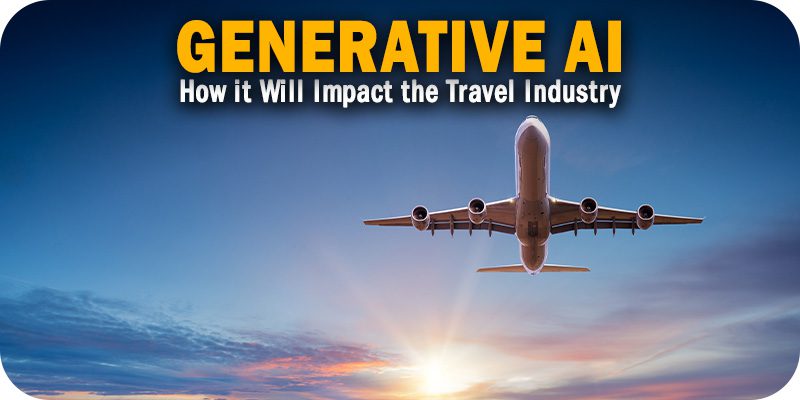As part of Solutions Review’s Premium Content Series—a collection of contributed columns written by industry experts in maturing software categories—Jason LaBaw, the Founder and CEO of Social Bee, outlines how generative AI technologies can (and will) impact the travel industry.

Cut to 2023, and generative artificial intelligence (AI) is already shaping up to be the sword needed to unlock a new era in travel. Despite launching with initial limitations, such as being less accurate after 2021, the potential of generative AI, such as ChatGPT and Google’s Bard, has received much attention from professionals across industries and the general public.
Unlike traditional AI, used more for analysis, this latest evolution utilizes large language models (LLMs) and chatbot functions to converse with users and generate new content based on user inputs. This is a game changer for travelers who could soon use such tools to produce detailed itineraries worldwide catered to their unique interests, likes, and dislikes. It’s also an estimated $28 billion-plus opportunity for the travel industry.
Let’s explore how.
From AI to Generative AI
AI allows you to take millions of data sets from all over the world and react quickly to that information. It’s already had a massive impact on the travel industry’s ability to read vast amounts of data, detect patterns, and personalize its product and service offerings.
Generative AI can already offer many suggestions for activities at your chosen destination. But the current limitation, exemplified in platforms like ChatGPT and Bard, is that it produces a text-based itinerary akin to a blog post that users cannot act from. Instead, users must manually copy, paste, search, and book the activities and accommodations suggested.
The next evolution of generative AI will facilitate booking flights, accommodations, and excursions with integrations directly from the AI interface. For example, OpenAI, the developers behind ChatGPT, are already working on expanding its web search capabilities with various plug-ins so the chatbot can source real-time information from sites such as Expedia and Instacart.
In the future, travelers will receive a seamless end-to-end travel planning experience that’s as easy to use as an online booking site. With elevated search functions, generative AI could also use this real-time information on weather patterns, flight prices, and possible travel restrictions to create the most optimized itineraries. Rather than spending countless hours conducting this kind of research, which can intimidate and confuse many prospective travelers, generative AI would be able to gather everything you need to know in a matter of seconds—and book it for you too.
Consumer-Focused AI
From personal preferences and current individual itineraries, customer reviews, historical data, news coverage, weather forecasts, and crime reports, the list of data points generative AI could draw from goes on. Travelers’ planning experience is better informed by the millions of more data points that the AI can handle.
This is how generative AI will help the travel industry become more consumer-focused. While the current generative AI platforms often require some degree of prompt engineering knowledge to extract maximum value, future generative AI platforms will offer a more structured and intuitive user experience. Effectively, this will eliminate the need for users to be experts in LLMs to obtain high-quality results for their queries. Conversely, to a mass-marketing approach, conversational and generative AI will help travelers focus on their interests and create the most unique trip possible.
A Happy Customer is a Loyal One
The customer retention rate across industries is, on average, 75 percent. However, the hospitality, travel, and restaurant industry has the lowest customer retention rate at 55 percent. Customer loyalty across the sector has room for improvement, and it’s a valuable business strategy as statistics also show it’s 40-65 percent easier to sell to an existing customer than a new one.
AI can already remember customer preferences and provide a layer of personalized service offerings based on their previous behavioral and buying patterns. However, generative AI can transform these recommendations into actionable itineraries for buyer conversions. It can also help the industry utilize past purchase history to enhance the customer’s tour, excursion, or experience.
For travel agents, generative AI represents an opportunity to offer more travel options for their clients that may extend beyond their domain of expertise or regional specialization. This could mean offering tailored activity itineraries and serving customized menus for hotels and restaurants. When people have a good and memorable experience, they’ll want to come back. Maybe you’re a hotel franchise looking to be people’s first choice in a new city, or an independent operator offering a unique trip looking for repeat buyers, client attraction is one thing, but client retention can be the make or break of your business.
While AI won’t make luxury accommodations accessible to those on a budget, it will arm budget-conscious travelers with itinerary options within their specified budget that are optimized and personalized. Likewise, those with higher budgets will have even more curated options from itineraries tailored to their specific preferences. However, no matter the traveler’s budget, generative AI’s most significant impact is its potential to revolutionize the travel industry by making it easier, more personalized, and more efficient for travelers to plan their trips.
- How Generative AI Will Impact the Travel Industry - June 30, 2023

